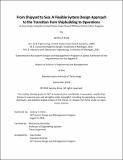From Shipyard to Sea: A Flexible System Design Approach to the Transition from Shipbuilding to Operations A Case Study Using the United States Coast Guard Offshore Patrol Cutter Program
Author(s)
Kime, Jeremy A.
DownloadThesis PDF (14.33Mb)
Advisor
de Neufville, Richard
Terms of use
Metadata
Show full item recordAbstract
The United States Coast Guard faces significant challenges transitioning new ships from shipbuilding to operations. Historically the low volume and irregular pace of major ship deliveries, combined with diverse homeporting factors, have resulted in anomalous post-delivery requirements. Today, a growing fleet, personnel shortages, and sweeping technological advancements are amplifying the complexity of post-delivery activities. At the same time, the Coast Guard is engaged in its largest shipbuilding effort since World War II, with seven acquisition programs scheduled to deliver 134 new ships over the next 15 years. In light of these factors the current approach, which places significant strain on crews, escalates costs, and delays operational use of the Coast Guard’s newest assets, warrants thorough examination. This thesis examines the issue through case study analyses using the Offshore Patrol Cutter (OPC) Program. The Coast Guard’s challenges are driven by three primary factors: the inherent uncertainty in ship construction, sociotechnical system dynamics associated with organizational management of pre-commissioning crews, and the ongoing evolution of technology. To address these challenges, this analysis employs an integrated approach, synthesizing principles and techniques from Architecting Innovative Enterprise Strategy (ARIES), Flexible Engineering Design (FED), and System Design and Management (SDM). This systems thinking approach aims to develop opportunities to reduce costs, improve schedules, and optimize workforce outcomes. The analysis recommends a three-phased strategy that could yield cost savings on the order of $400 million over the OPC Program’s lifespan, significantly mitigate risks associated with unforeseen shipbuilding developments, and enhance organizational outcomes regarding workforce, operational availability, and life cycle sustainment. The staffing of pre-commissioning crews is pinpointed as a pivotal discretionary event that triggers an exponential increase in system complexity and a surge in scope by introducing interdependent yet organizationally disparate requirements. Consequently, major personnel activities are decoupled from highly variable ship construction milestones. This paves the way for a paradigm shift from fixed to flexible approaches, replacing fragmented, ad hoc approaches with a flexible system architecture capable of continuous enterprise learning and improvement. Dynamic post-delivery activities are reimagined as a continuous business line, to professionalize the transition of new ships from shipbuilding to operations.
Date issued
2024-09Department
System Design and Management Program.Publisher
Massachusetts Institute of Technology